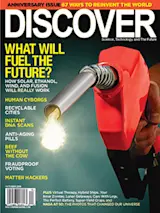Voting machines are one of the few areas where technology has decidedly taken us a step backward. The electronic voting machines that one-third of American voters will be using in November are no more reliable than your home computer.
Direct-recording electronic voting machines are incredibly easy to hack; Princeton University security expert Ed Felten proved it by accessing a Diebold machine’s memory card with a hotel minibar key he bought online. In less than one minute, Felten was able to install undetectable vote-stealing software. Then there is the garden-variety computer error. Touch-screen machines in Sarasota, Florida, recorded an 18,000-vote undercount in a congressional race decided by fewer than 400 votes. Paper itself was never foolproof (remember those chads?), but a stolen, lost, or stuffed ballot box risks mere hundreds of votes while a hidden computer glitch risks millions. And since viruses can spread, one machine’s infection can quickly cross county ...














